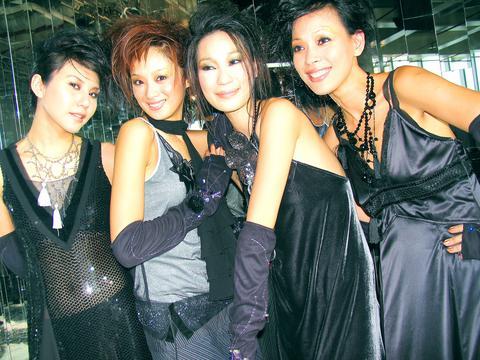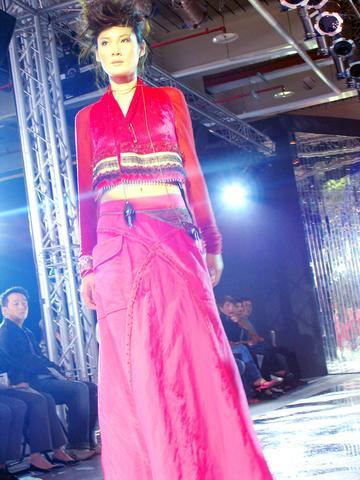The show had to go on despite an angry Typhoon Aere. Models queued up for their turn on the catwalk to breezily parade the Autumn/Winter collection of one of the country's top designers, Fu Zi-jing (
The event, held Tuesday at a sandbagged building in central Taipei, was a kind of coming-out party for a designer who has been a leading light on the local fashion scene for over a decade. Dresses in cherry red, bright pinks and blues loudly announced that Fu was taking a departure from her more usual black and neutral tones, for what she called a "romantic" look.

PHOTO: JULES QUARTLY, TAIPEI TIMES
Her signature black gowns were elegantly put together with the usual painstaking eye for detail, as shown by the embroidered hems, cut lines, folds, accessories and wide-range of fabrics, many of them from original designs.

PHOTO: JULES QUARTLY, TAIPEI TIMES
But it was the red outfit, with the long-sleeved top and Tibetan-ethnic highlights, a bare-midriff and long skirt, that grabbed the attention. A pale indigo, robe-cum-cardigan worn over calf-length trousers was in a similar vein. If this relative explosion of color is a new direction, it would seem from the reaction of those there that it was going the right way.
"She hasn't really used red before, her style has changed a lot," said public relations director Ginny Chang (
"Though she has become famous, this became a bit of a headache for her. She was not happy with her collection. She tried to relax in her personal life and work. This effected her design, which has become more soft and mature.
Fu said her collection was inspired by the idea of opening a treasure box and said each design was the result of an idea or concept derived from an opera, a painting, a movie theme, an experience or a book.
Fashion photographer Mai Xian-yun (
"You can't compare Fu with other designers. In the beginning she [incorporated] foreign cultures and designers. She's now moved on from this. Everyone wants an international market, but its difficult to do this. Fu Zi-jing is one of the few designers to have the opportunities."
"Taiwan fashion is quite different from the rest of the world," Mai said, adding the leading players had all been successful abroad. He mentioned Sophie Hong (
"That's the concern about the next generation, many of them don't know the next step to make it international. They have a Taiwan market, but they need international looks."
Rather than just catering to niche markets locally, Mai said, the aim should be to develop a broader appeal in order to break into Europe, Japan and the US. "China is, of course, a massive opportunity for us."
Mai also said there was a need to co-opt the media and government so they could build a platform for designers to be noticed. But the recent Ministry of Economic Affairs-led initiative to give the fashion industry a lift, with the ambitious "Fuse 2004" program, has been a disappointment.
A planned month-long fashion party this month showcasing young talent was promoted as "linking Taiwan fashion design talents globally." It turned out to be a washout, with just one cat-walk show and an exhibition taking place.
A typhoon could not stop Fu Zi-jing. Perhaps there are lessons to be learned here.

April 14 to April 20 In March 1947, Sising Katadrepan urged the government to drop the “high mountain people” (高山族) designation for Indigenous Taiwanese and refer to them as “Taiwan people” (台灣族). He considered the term derogatory, arguing that it made them sound like animals. The Taiwan Provincial Government agreed to stop using the term, stating that Indigenous Taiwanese suffered all sorts of discrimination and oppression under the Japanese and were forced to live in the mountains as outsiders to society. Now, under the new regime, they would be seen as equals, thus they should be henceforth

Last week, the the National Immigration Agency (NIA) told the legislature that more than 10,000 naturalized Taiwanese citizens from the People’s Republic of China (PRC) risked having their citizenship revoked if they failed to provide proof that they had renounced their Chinese household registration within the next three months. Renunciation is required under the Act Governing Relations Between the People of the Taiwan Area and the Mainland Area (臺灣地區與大陸地區人民關係條例), as amended in 2004, though it was only a legal requirement after 2000. Prior to that, it had been only an administrative requirement since the Nationality Act (國籍法) was established in

Three big changes have transformed the landscape of Taiwan’s local patronage factions: Increasing Democratic Progressive Party (DPP) involvement, rising new factions and the Chinese Nationalist Party’s (KMT) significantly weakened control. GREEN FACTIONS It is said that “south of the Zhuoshui River (濁水溪), there is no blue-green divide,” meaning that from Yunlin County south there is no difference between KMT and DPP politicians. This is not always true, but there is more than a grain of truth to it. Traditionally, DPP factions are viewed as national entities, with their primary function to secure plum positions in the party and government. This is not unusual

The other day, a friend decided to playfully name our individual roles within the group: planner, emotional support, and so on. I was the fault-finder — or, as she put it, “the grumpy teenager” — who points out problems, but doesn’t suggest alternatives. She was only kidding around, but she struck at an insecurity I have: that I’m unacceptably, intolerably negative. My first instinct is to stress-test ideas for potential flaws. This critical tendency serves me well professionally, and feels true to who I am. If I don’t enjoy a film, for example, I don’t swallow my opinion. But I sometimes worry